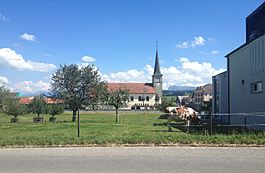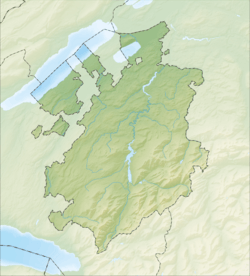Siviriez facts for kids
Quick facts for kids
Siviriez
|
||
|---|---|---|
 |
||
|
||
| Country | Switzerland | |
| Canton | Fribourg | |
| District | Glâne | |
| Area | ||
| • Total | 20.28 km2 (7.83 sq mi) | |
| Elevation | 777 m (2,549 ft) | |
| Population
(Dec 2020 )
|
||
| • Total | 2,346 | |
| • Density | 115.68/km2 (299.61/sq mi) | |
| Postal code |
1678
|
|
| Surrounded by | Billens-Hennens, Brenles (VD), Esmonts, Le Flon, Mézières, Romont, Ursy, Vuisternens-devant-Romont | |
Siviriez is a town, also called a municipality, located in the Glâne district. It's part of the canton of Fribourg in Switzerland.
Contents
A Look at Siviriez's Past
Siviriez was first written about in the year 1147. Back then, its name was Sivrie.
How Siviriez Grew Over Time
Over the years, Siviriez grew by joining with other nearby towns.
- On January 1, 1978, the towns of Villaranon and Le Saulgy became part of Siviriez.
- Later, in 2004, Prez-vers-Siviriez, Villaraboud, and Chavannes-les-Forts also joined Siviriez.
Understanding Siviriez's Geography
Siviriez covers an area of about 20.3 square kilometers (which is about 7.8 square miles). Most of this land, about 74.5%, is used for farming. Another 17.2% is covered by forests. About 8% of the land has buildings or roads. A very small part, 0.2%, is rivers or lakes. The rest, also 0.2%, is land that cannot be used for farming or building.
What the Land is Used For
- In the built-up areas, about 4.9% is for homes and other buildings.
- Roads and other transport paths make up 2.9%.
- For the forested areas, 15.6% is dense forest.
- The remaining 1.6% has orchards or small groups of trees.
- On the farmland, 29.4% is used to grow crops.
- A larger part, 44.2%, is used as pastures for animals.
- All the water in Siviriez is flowing water, like rivers and streams.
Siviriez's Coat of Arms
The blazon (description) of Siviriez's coat of arms is quite detailed. It shows a red background with a wavy blue line at the bottom. Above this line, there is half of a golden lion standing up. This lion appears from white hills. At the very top, there are two white stars with holes in them.
Who Lives in Siviriez: Demographics
Siviriez has a population of 2,346 people. About 9.3% of the people living in Siviriez are from other countries. Over the last 10 years (from 2000 to 2010), the number of people living here grew by 14.3%. Most of this growth (13.5%) was from people moving into Siviriez. The rest (1.6%) was from more births than deaths.
Languages Spoken in Siviriez
Most people in Siviriez speak French as their main language.
- About 93.5% of the population speaks French.
- The second most common language is Portuguese, spoken by 2.7% of people.
- German is the third, spoken by 1.8%.
- A very small number of people, 2, speak Italian.
Where People Were Born
- About 40.3% of the people in Siviriez were born there.
- Another 33.4% were born in the same canton (Fribourg).
- About 11.2% were born somewhere else in Switzerland.
- And 10.6% were born outside of Switzerland.
Age Groups in Siviriez
- Children and teenagers (0–19 years old) make up 30.7% of the population.
- Adults (20–64 years old) make up 55.2%.
- Seniors (over 64 years old) make up 14.1%.
Households and Homes
In Siviriez, there are about 634 private households. On average, there are 2.8 people living in each home.
- 74 households have only one person.
- 37 households have five or more people.
Most apartments (92%) are lived in all the time. A small number (5.2%) are used only at certain times of the year, like for holidays. About 2.9% of apartments are empty.
Population Changes Over Time
The chart below shows how the population of Siviriez has changed through history:

Important Sights in Siviriez
The whole village of Chavannes-les-Forts is a special place. It is recognized as part of the Inventory of Swiss Heritage Sites. This means it has important historical or cultural value.
Siviriez's Economy: How People Work
In 2010, the unemployment rate in Siviriez was 2%. This means only a small number of people who wanted to work couldn't find a job.
Jobs in Different Sectors
In 2008, many people worked in different types of jobs:
- Primary Sector: 203 people worked in this sector, which includes farming and forestry. There were 73 businesses in this area.
- Secondary Sector: 148 people worked in this sector, which includes manufacturing and construction. There were 29 businesses.
- Tertiary Sector: 229 people worked in this sector, which includes services like shops, healthcare, and education. There were 44 businesses.
Out of all the people working, about 39.3% were women.
Full-Time Jobs in Siviriez
In 2008, there were 448 full-time equivalent jobs in Siviriez.
- Primary Sector: 144 jobs, mostly in agriculture (142 jobs).
- Secondary Sector: 139 jobs. About 42.4% were in manufacturing, and 56.8% were in construction.
- Tertiary Sector: 165 jobs.
- 30.3% were in sales or vehicle repair.
- 6.7% were in hotels or restaurants.
- 10.3% were technical experts or scientists.
- 10.3% were in education.
- 36.4% were in healthcare.
Commuting to Work
In 2000, 129 workers came into Siviriez for their jobs. However, 280 workers left Siviriez to work in other towns. This means more people leave Siviriez for work than come in.
- 6% of working people used public transportation to get to work.
- 64.1% used their own private car.
Religion in Siviriez
Based on the 2000 census, most people in Siviriez are Christian.
- About 85.7% were Roman Catholic.
- 3.1% belonged to the Swiss Reformed Church.
- A small number (0.31%) were members of an Orthodox church.
- About 2.49% belonged to other Christian churches.
- 1.66% of the population were Islamic.
- About 3.11% of people said they did not belong to any church, or were agnostic or atheist.
- 4.77% did not answer the question about their religion.
Education in Siviriez
Education is very important in Switzerland.
- About 26.7% of people in Siviriez have finished non-mandatory upper secondary education. This is like high school.
- 8.2% have gone on to higher education, like university or a special technical college (Fachhochschule).
The Fribourg School System
The school system in the Canton of Fribourg works like this:
- Kindergarten: One year of optional (not required) kindergarten.
- Primary School: Six years of primary school.
- Lower Secondary School: Three years of required lower secondary school. Students are grouped based on their abilities.
- Upper Secondary School: After lower secondary, students can choose a three or four-year upper secondary school. This can be a gymnasium (which prepares them for university) or a vocational program (which teaches job skills).
- Tertiary School: After upper secondary, students can go to a university or continue their apprenticeship (on-the-job training).
Students in Siviriez Schools (2010–2011)
During the 2010–2011 school year, 221 students attended 15 classes in Siviriez.
- There were 4 kindergarten classes with 48 students.
- There were 10 primary classes with 165 students.
- There was one lower secondary class with 8 students.
- Siviriez did not have upper secondary or vocational classes. However, 34 upper secondary students and 84 vocational students from Siviriez went to schools in other towns.
- Siviriez also did not have non-university tertiary classes. But 6 non-university tertiary students and 3 specialized tertiary students from Siviriez went to schools in other towns.
In 2000, 2 students came to Siviriez from other towns for school. At the same time, 67 students from Siviriez went to schools outside the municipality.
See also
 In Spanish: Siviriez para niños
In Spanish: Siviriez para niños





